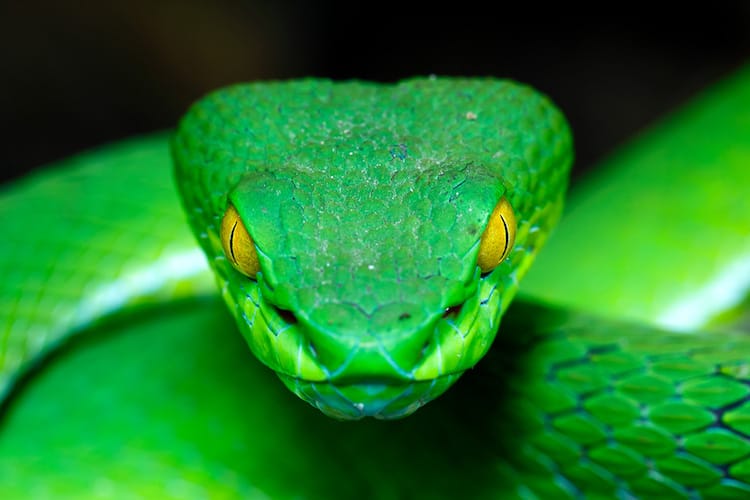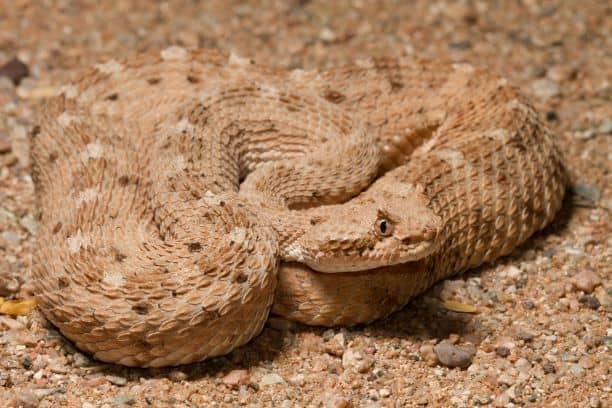Sandy slitherer One of the three sidewinding snakes studied in this work, the sidewinder rattlesnake (Crotalus cerastes) lives in the deserts of the southwestern US and northern Mexico. (Courtesy: Wolfgang Wuster)”>
Snakes that specialize in “sidewinding” – that is, travelling at an angle relative to the direction their head is pointing – have tiny pits on their stomachs that even out the friction they feel as they move. These pits are very different from the spiky structures found on the bellies of conventionally-slithering snakes, and the US-based scientists who discovered them suggest that they evolved to help sidewinders move more easily in desert habitats.
While most snakes keep their entire bodies on the ground as they travel, sidewinders repeatedly lift portions of themselves off the surface. Previous studies suggested that this pattern of movement helps the snakes spread their weight, reducing their chances of triggering avalanches as they cross steep, sandy slopes.
In the latest work, published in PNAS, physicists Jennifer Rieser of the Georgia Institute of Technology (Georgia Tech) and Tai-De Li of the City University of New York found further clues to the sidewinders’ success. Working with colleagues at Georgia Tech, the University of California Riverside and Zoo Atlanta, they used atomic force microscopy (AFM) to compare skins shed by three sidewinding species – the sidewinder rattlesnake (Crotalus cerastes), the Saharan horned viper (Cerastes cerastes) and the Saharan sand viper (Cerastes vipera) – with samples from non-sidewinding snakes.
Slip-sliding away
The AFM images showed that snakes that move in typical undulating fashion, with s-shaped waves travelling from head to tail, have micrometre-sized, rearward-facing spikes along their bellies. In the sidewinder rattlesnake, which lives in the southwestern US, these spikes are smaller and less prominent, while the two Saharan vipers have no spikes at all. Instead, the sidewinders’ undersides are studded with a uniform pattern of microscopic pits.
To understand how these structures affect movement, the researchers developed a mathematical model of the friction the snakes experience as they move. The model showed that the spikes produce a frictional force that depends on snakes’ direction of travel. “We think that these spiky structures act kind of like corduroy,” Rieser explains. “If you can imagine yourself running your fingers down the ridges of a corduroy pattern, it’s maybe easier than going across all the bumps.”
In non-sidewinding species, this directional friction works to the snakes’ advantage, as it reduces their chances of slipping backwards. For sidewinders, though, it’s a disaster. “If you’re trying to sidewind, the way that you’re applying forces to the ground would basically mean you’re almost fighting yourself to move forward,” Rieser tells Physics World. “You would be generating a backwards force.” Although the non-directional structure of the sidewinders’ pits is not as efficient for forward undulation, she adds, it does enhance sidewinding.
Biological inssssspiration
Apart from enhancing our understanding of snake biology, Rieser says the group’s findings could have applications in robotics. “This, long, slender body plan has evolved many times, not just in snakes, so trying to understand more about the environmental pressures that have led to this body plan and how that might be conducive to movement in certain kinds of environments would be a very interesting path forward,” she says.

Snake vision inspires pyroelectric material design
As for the differences between the sidewinder rattlesnake and the two Saharan species, Rieser, who is now at Emory University, credits her co-author Jessica Tingle with a plausible hypothesis. Because the Sahara Desert is geologically much older than the arid landscape of the American southwest, Tingle suggested that sidewinding behaviour may have evolved earlier in the Saharan species. “Maybe, given more time, these spikes would disappear in the North American sidewinders as well,” Rieser says.
